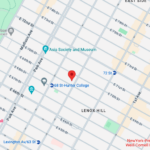Runners are going to run, even in a big city. In New York, runners can kick up their heels in plenty of parks. But when ankle pain makes it near impossible to hit the pavement, runners can see one of the ankle specialists at New York Bone & Joint Specialists if they need an ankle arthroscopy procedure to get the bounce back in their step.
Don’t let ankle pain sideline you indefinitely. If you’ve exhausted conservative treatments without success, ankle arthroscopy may be the breakthrough solution that restores your mobility and returns you to the activities you enjoy.
What is Ankle Arthroscopy?
Ankle arthroscopy is a state-of-the-art, minimally invasive surgical procedure that allows orthopedic surgeons to diagnose and treat ankle problems through tiny incisions, typically just 3-4 millimeters in size. This advanced technique represents a significant improvement over traditional open surgery, which requires large incisions and extensive tissue disruption.
Making ankle arthroscopy possible are innovative tools and technology. Through one small incision, the surgeon inserts an arthroscope, a flexible tube with a light and video camera at the end, into the ankle joint.
The camera takes pictures of the inside of the ankle and projects those images on a computer screen. Using those images, the surgeon can evaluate the damage and see what needs to be repaired. The surgeon also makes other small incisions where he can insert special instruments to fix the ankle.
Ankle Arthroscopy Procedure: What to Expect
Your surgeon will go over the procedure with you in detail before ankle arthroscopy. But here’s what to expect:
Pre-op:
- Your doctor will review your medications and tell you what to take and not take before the procedure. You may have to stop blood thinners.
- Don’t smoke or drink before the surgery.
- Don’t eat or drink 12 hours before the surgery.
During the ankle arthroscopy procedure:
- Regional or light general anesthesia will be given.
- About 3 small incisions will be made in the ankle for the arthroscope and other instruments to enter.
- Images from the arthroscope camera will guide the surgeon to the damaged areas.
- The surgeon will repair compromised cartilage, torn ligaments, or other damage.
- The procedure takes about an hour to 90 minutes, depending on the damage.
- Discharge the same day from the hospital or surgical facility.
Conditions Treated with Ankle Arthroscopy
Ankle arthroscopy is recommended when other non-surgical conservative methods fail to bring relief. In general, ankle arthroscopy is the best choice for these ankle conditions
- Ankle impingement syndrome. Inability to move the joint due to extreme swelling of the soft tissue.
- Ligament tears. A ligament connecting the bones in the ankle is torn.
- Cartilage injuries. Ankle arthroscopy can diagnose and repair cartilage damage in the ankle.
- Loose bodies. Pieces of bone or cartilage get loose in the ankle and restrict range of motion.
- Ankle instability. A bone deformity or other abnormality can make you feel unsteady on your feet.
- Scar tissue. Scar tissue can build up in the ankle due to previous injuries.
- Osteochondral lesions. A crack in the cartilage lining the ankle.
- Synovitis. A swelling of the synovial membrane lining the ankle joint seen mostly in people with arthritis.
Ankle Arthroscopy Recovery: Timeline and Expectations
Ankle arthroscopy recovery period depends on the severity of the injury or damage. But your timeline may follow these guidelines.
First 24 to 48 hours
- Use a walker or crutches to keep weight off the ankle
- Keep your foot elevated as much as possible.
- Apply a cold compress to reduce swelling.
- Can shower but don’t get the dressing wet.
- Change bandages and keep the surgical area clean following your doctor’s insrtructions.
- Take pain medications as directed.
In the first few weeks after ankle arthroscopy
- Your doctor may have you wear a cast, brace ,or boot on your foot to stabilize the ankle. He will tell you how long to wear the device.
- Walk as much as possible to prevent blood clots.
- Rest for one to two weeks before resuming normal activities.
- Start physical therapy.
When to return to work/exercise
- Office workers can return to work within several days.
- Workers on jobs requiring heavy lifting, long periods standing or walking may return to work after one to two months.
- Athletes can resume training and exercising within four to six weeks.
“Ankle arthroscopy allows us to diagnose and treat complex ankle problems through tiny incisions, resulting in less pain and faster healing than traditional open surgery. This minimally invasive approach helps us address cartilage damage, bone spurs, and ligament issues with precision.” – Dr. Leon Popovitz, MD, Co-Founder of New York Bone & Joint.
Before and After Ankle Arthroscopy: What Changes to Expect
Every patient experiences ankle pain and limitations differently. But ankle arthroscopy can greatly improve your quality of life.
Comparing the before and after ankle arthroscopy symptoms:
Before ankle arthroscopy:
- Persistent and worsening pain
- Ankle pain during and after exercise
- Limited mobility and stiffness
- Pain when climbing stairs
- Ankle hurts when it rains
After ankle arthroscopy:
- Less or no ankle pain. You can manage immediate post-op discomfort with pain medication.
- Better mobility after recovery, including climbing stairs and walking.
- Can resume normal activities after a few weeks rest.
- Strenuous exercise can begin within four to six weeks.
Benefits of ankle arthroscopy
As a minimally invasive procedure, ankle arthroscopy provides these advantages:
- Smaller incisions mean less scarring and pain.
- Shorter recovery time compared to open surgery.
- Return to normal activities and work within days or weeks.
- Less risk of complications, such as infection.
- Minimal damage to surrounding soft tissue.
- Same-day surgery.
Risks and Complications
Every surgery, even ankle arthroscopy, carries some measure of risk. An experienced ankle surgeon can minimize those risks.
General surgical risks:
- Infection
- Allergic reaction to the anesthesia
- Blood clots
- Excessive bleeding and swelling
Risks for ankle arthroscopy:
- Damage to tissue and nerves in the ankle, foot, or leg.
- Numbness or tingling in the ankle or foot.
Risk prevention:
- Keep the incision area clean and dry for one to two days.
- Change the dressing when instructed by your doctor.
Call your doctor if experience these symptoms:
- Intense pain or bleeding
- Fever
- Discoloration at the incision site
- Nausea and vomiting
Success rate: According to one study, ankle arthroscopy success rate hovers around 90 percent, with complications in the 3.5 percent to 14 percent range.
Post-Surgery Care Instructions
A successful recovery from ankle arthroscopy depends on what you do following the surgery.
Wound care:
- Keep the dressing dry and clean for 48 to 72 hours after the surgery. You can change the dressing after that time, but follow the doctor’s instructions.
- If you have strips over the incision, leave them on until they fall off or take them off after a week.
- If the incisions are open to the air, keep them clean and dry.
Weight-bearing restrictions:
Immediately after the surgery:
- You’ll wear a boot or splint to protect the ankle.
- Use crutches or a walker to keep weight off the ankle.
- Apply a cold compress to the ankle for 10 to 20 minutes at a time every one to two hours.
- Elevate the ankle above the heart to promote healing and blood flow.
- Physical therapy can begin a few days after surgery.
Pain management. Over the counter or prescription pain medications can make you comfortable. Take as instructed.
Return to activities. You can return to light activities or work within a few days or weeks. For athletes, returning to physical activity may take months.
Physical Therapy After Ankle Arthroscopy
To build up strength and flexibility to the joint after ankle arthroscopy, physical therapy will begin within days of surgery.
- Immediately after surgery move your toes within the bandages and walk as much as you can with a walker or crutches, increasing your distance gradually.
- Physical therapy for ankle arthroscopy focuses on ankle and leg movements to strengthen the muscles of the joint and increase range of motion.
- Exercises will change based on how much weight you can bear on the ankle. You’ll begin non-weight-bearing exercises first.
- A physical therapy program for ankle arthroscopy will consist of two to three sessions a week for six to eight weeks.
- A physical therapist will show you how to do the exercises safely at home.
Goal of physical therapy
- To restore range of motion and the strength of the ankle prior to surgery.
- Improve gait, balance, and posture.
- Most people can return to their normal activities within weeks. For athletes, the timeline is longer.
Why choose us for ankle arthroscopy surgery in NYC?
For decades, New Yorkers have put their trust in our ankle arthroscopy doctors and surgeons. Our leadership in the field is a testament to:
- Comprehensive & Compassionate Care: Our world-class specialists offer expert, empathetic guidance, from diagnosis to rehabilitation.
- Commitment to Joint Health: We understand the vital role your joints play in an active and fulfilling life, and we prioritize their health and healing.
- Effective Non-Surgical Solutions: We successfully resolve over 90% of ankle pain cases with orthopedic treatments, often avoiding surgery.
- Dedication to Your Full Recovery: We are committed to your complete recovery, utilizing conservative methods and only resorting to expert surgical intervention when absolutely necessary.
NYC’s Top-Rated Ankle Arthroscopy Specialists
At New York Bone & Joint Specialists, our philosophy centers on preserving your body’s natural structures, particularly for long-term ankle health. This commitment to exceptional care means 90% of our patients recover without surgery, ensuring lasting health and function, and offering peace of mind.
Make an appointment today
Ready to take the first step toward relief? Schedule an appointment with New York Bone & Joint Specialists and start your personalized recovery plan today.
Ankle Arthroscopy: FAQs
How long is ankle arthroscopy recovery time?
Ankle arthroscopy recovery time depends on the severity of the damage and your activity level. For people with sedentary jobs, they can return to work within days. However, they may have to get around on crutches or a boot for a week or so. Full recovery for athletes and more active people may take months. After ankle arthroscopy, you’ll begin a graduated physical therapy program to restore full function to your ankle.
Can I walk immediately after an ankle arthroscopy?
Yes, you’re encouraged to walk after ankle arthroscopic surgery and gradually increase your distance. Staying active prevents blood clots. But remember, you’ll have to walk on a boot or with crutches to keep weight off the ankle as it heals for a period of time. Your doctor will give you the go-ahead to take off the boot and put more weight on your ankle.
When can I return to sports after an ankle arthroscopy?
Recovery from ankle arthroscopy can stretch for months for athletes and more active individuals. It can be sooner if you follow a physical therapy program. Less active people can resume normal activities within weeks.
Is ankle arthroscopy painful?
No, as a minimally invasive procedure, ankle arthroscopy is not painful. You’ll be given general or local anesthesia to block the pain. After the surgery, you can take OTC pain relievers, or your doctor will give a prescription for stronger pain relief. Physical therapy can also help reduce any post-op pain.
How successful is ankle arthroscopy?
Ankle arthroscopy is extremely successful and effective in helping people overcome ankle pain. One study put the success rate at 90 percent, with very few complications.











